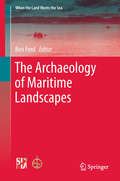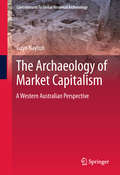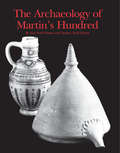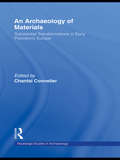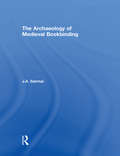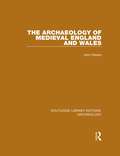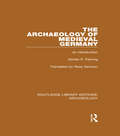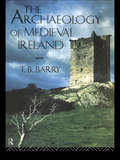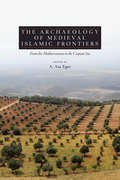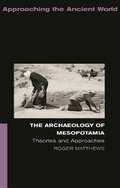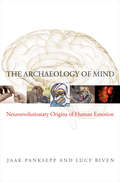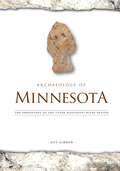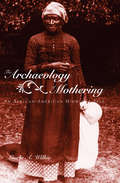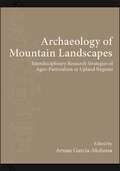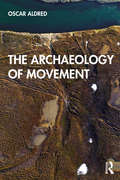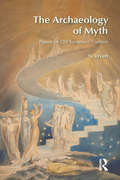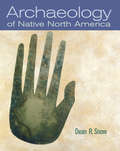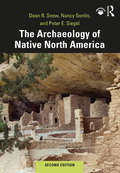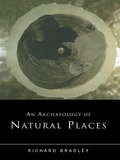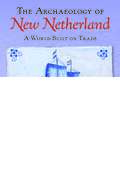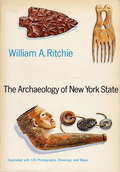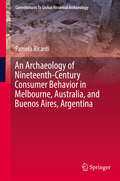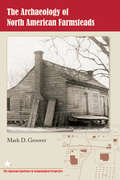- Table View
- List View
The Archaeology of Maritime Landscapes
by Ben FordMaritime cultural landscapes are collections of submerged archaeological sites, or combinations of terrestrial and submerged sites that reflect the relationship between humans and the water. These landscapes can range in size from a single beach to an entire coastline and can include areas of terrestrial sites now inundated as well as underwater sites that are now desiccated. However, what binds all of these sites together is the premise that each aspect of the landscape -cultural, political, environmental, technological, and physical - is interrelated and can not be understood without reference to the others. In this maritime cultural landscape approach, individual sites are treated as features within the larger landscape and the interpretation of single sites add to a larger analysis of a region or culture. This approach provides physical and theoretical links between terrestrial and underwater archaeology as well as prehistoric and historic archaeology; consequently, providing a framework for integrating such diverse topics as trade, resource procurement, habitation, industrial production, and warfare into a holistic study of the past. Landscape studies foster broader perspectives and approaches, extending the study of maritime cultures beyond the shoreline. Despite this potential, the archaeological study of maritime landscapes is a relatively untried approach with many questions regarding the methods and perspectives needed to effectively analyze these landscapes. The chapters in this volume, which include contributions from the United States, the United Kingdom, Norway, and Australia, address many of the theoretical and methodological questions surrounding maritime cultural landscapes. The authors comprise established scholars as well as archaeologists at the beginning of their careers, providing a healthy balance of experience and innovation. The chapters also demonstrate parity between method and theory, where the varying interpretations of culture and space are given equal weight with the challenges of investigating both wet and dry sites across large areas.
The Archaeology of Market Capitalism
by Gaye NaytonThe area claimed by the British Empire as Western Australia was primarily colonized through two major thrusts: the development of the Swan River Colony to the southwest in 1829, and the 1863 movement of Australian born settlers to colonize the northwest region. The Western Australian story is overwhelmingly the story of the spread of market capitalism, a narrative which is at the foundation of modern western world economy and culture. Due to the timing of settlement in Western Australia there was a lack of older infrastructure patterns based on industrial capitalism to evoke geographical inertia to modify and deform the newer system in many ways making the systemic patterns which grew out of market capitalist forces clearer and easier to delineate than in older settlement areas. However, the struggle between the forces of market capitalism, settlers and indigenous Australians over space, labor, physical and economic resources and power relationships are both unique to place and time and universal in allowing an understanding of how such complicated regional, interregional and global forces shape a settler society. Through an examination of historical records, town layout and architecture, landscape analysis, excavation data, and material culture analysis, the author created a nuanced understanding of the social, economic, and cultural developments that took place during this dynamic period in Australian history. In examining this complex settlement history, the author employed several different research methodologies in parallel, to create a comprehensive understanding of the area. Her research techniques will be invaluable to researchers struggling to understand similarly complex sociocultural evolutions throughout the globe.
The Archaeology of Martin's Hundred: Part 1, Interpretive Studies; Part 2, Artifact Catalog
by Ivor Noël Hume Audrey Noël HumeThe Archaeology of Martin's Hundred explores the history and artifacts of a 20,000-acre tract of land in Tidewater, Virginia, one of the most extensive English enterprises in the New World. Settled in 1618, all signs of its early occupation soon disappeared, leaving no trace above ground. More than three centuries later, archaeological explorations uncovered tantalizing evidence of the people who had lived, worked, and died there in the seventeenth century.Part I: Interpretive Studies addresses four critical questions, each with complex and sometimes unsatisfactory answers: Who was Martin? What was a hundred? When did it begin and end? Where was it located? We then see how scientific detective work resulted in a reconstruction of what daily life must have been like in the strange and dangerous new land of colonial Virginia. The authors use first-person accounts, documents of all sorts, and the treasure trove of artifacts carefully unearthed from the soil of Martin's Hundred.Part II: Artifact Catalog illustrates and describes the principal artifacts in 110 figures. The objects, divided by category and by site, range from ceramics, which were the most readily and reliably datable, to glass, of which there was little, to metalwork, in all its varied aspects from arms and armor to rail splitters' wedges, and, finally, to tobacco pipes.The Archaeology of Martin's Hundred is a fascinating account of the ways archaeological fieldwork, laboratory examination, and analysis based on lifelong study of documentary and artifact research came together to increase our knowledge of early colonial history.Copublished with the Colonial Williamsburg Foundation.
An Archaeology of Materials: Substantial Transformations in Early Prehistoric Europe (Routledge Studies in Archaeology)
by Chantal ConnellerAn Archaeology of Materials sets out a new approach to the study of raw materials. Traditional understandings of materials in archaeology (and in western thought more widely) have failed to acknowledge both the complexity and, moreover, the benefits of an analysis of materials. Here Conneller argues that materials cannot be understood independently of the practices through which they are constituted. Drawing on a number of different thinkers, and using case studies from the European early Prehistoric period, she investigates how we can rethink the properties of matter and the relationship of material and form. What emerges from this book is the variability and the specificity of human-material interactions and the rather more active role that matter plays in these than traditionally conceived. Rather than being insignificant, a formless substrate or simply a constraint to human action, it is argued that materials are more fundamental. Tracing the processes by which the properties of past materials emerge reveals the working of past worlds, particularly articulations of the cultural, the natural and the supernatural. This book will establish a new perspective on the meaning and significance of materials, particularly those involved in mundane, daily usage, and will be a timely addition to the literature on technologies and materials.
The Archaeology of Medicine in the Greco-Roman World
by Patricia A. BakerThis book teaches students and scholars of Greco-Roman medical history how to use and critically assess archaeological materials. Ancient medicine is a subject dominated by textual sources, yet there is a wealth of archaeological remains that can be used to broaden our understanding of medicine in the past. In order to use the information properly, this book explains how to ask questions of an archaeological nature, how to access different types of archaeological materials, and how to overcome problems the researcher might face. It also acts as an introduction to the archaeology of medicine for archaeologists interested in this aspect of their subject. Although the focus is on the Greco-Roman period, the methods and theories explained within the text can be applied to other periods in history. The areas covered include text as material culture, images, artifacts, spaces of medicine, and science and archaeology.
The Archaeology of Medieval Bookbinding
by J.A. SzirmaiIn the past, studies of the history of bookbinding were mainly concerned with the exterior decoration. This book focuses attention primarily on the physical aspects of the binding and its construction principles. It is an expanded version of a series of lectures delivered by the author while Visiting Professor at the University of Amsterdam in 1987, supplemented with the results of ten years of intensive research in major libraries on the Continent, the United Kingdom and the USA. It surveys the evolution of binding structures from the introduction of the codex two thousand years ago to the close of the Middle Ages. Part I reviews the scanty physical evidence from the Mediterranean heritage, the early Coptic, Islamic and Ethiopian binding structures and their interrelation with those of the Byzantine realm. Part II is devoted to a detailed analysis of Western binding techniques, distinguishing the carolingian, romanesque and gothic wooden-board bindings as the main typological entities; their structure and function is compared with those of contemporary limp bindings. The book is illustrated with over 200 drawings and photographs and contains a comprehensive bibliography.
The Archaeology of Medieval England and Wales (Routledge Library Editions: Archaeology)
by John SteaneIn the preceding 25 years to this book’s publication in 1985 there was an extensive and unprecedented burst of archaeological activity in evidence from below-ground deposits, above-ground structures, and artefacts. During the boom of the late 1960s and 1970s, which led to go much central town redevelopment, it was buried remains which yielded the most dramatic information. In the recession of the 1980s it was realised that upstanding remains had a lot to offer as well and they were being subject to ever more sophisticated study techniques. This book examines those recent developments in archaeology and assesses their bearing on the study of medieval English and Welsh history. Taking a series of important themes such as government, religion and the countryside, the book offers a chronological approach from the coming of the Vikings, 850 AD, to the Reformation in 1530. This approach focuses on the impact of man on the urban and rural landscape. An important text for students of ancient history.
The Archaeology of Medieval Germany: An Introduction (Routledge Library Editions: Archaeology)
by Günter P. FehringMedieval archaeology is a relatively young discipline. It relies heavily on and contributes to the neighbouring disciplines of history and geography as well as certain of the natural sciences. The kinds of sources investigated in the context of medieval archaeology also cast light on many aspects of life in later centuries. The main sources used are: graveyards, churches and churchyards; castles and fortifications; rural and urban settlements; technical production sites and routes of communication. Closely allied to these are the numerous finds of small objects of everyday life, from cutlery and tools to animal remains and grain. This book is a comprehensive discussion of what can be established from the use of such materials about the culture and daily life of medieval Germany. Each subject is augmented with the use of many illustrations. Besides methodological questions, the author considers what can be learnt about the history of settlement and architecture, of technology, of economic and social matters, of churches and missions, and of population, diet and vegetation.
The Archaeology of Medieval Ireland
by Terry B. Barry`This eagerly awaited book is an outstanding and right up-to-date summary of every excavation and investigation undertaken in Ireland into the earthworks, castles, ecclesiastical buildings and towns of the period from the arrival of the Anglo-Normans to the mid-sixteenth century...a most welcome synthesis and will be valued by the layperson, student and professional archaeologist, historical geographer and historian alike.' Archaeology Ireland
The Archaeology of Medieval Islamic Frontiers: From the Mediterranean to the Caspian Sea
by Anthony Lauricella Renata Holod Tarek Kahlaoui Ian Randall Giovanni R. Ruffini Jana Eger Karim Alizadeh Tasha Vorderstrasse Kathryn FranklinThe Archaeology of Medieval Islamic Frontiers demonstrates that different areas of the Islamic polity previously understood as “minor frontiers” were, in fact, of substantial importance to state formation. Contributors explore different conceptualizations of “border,” the importance of which previously went unrecognized, examining frontiers in regions including the Magreb, the Mediterranean, Egypt, Nubia, and the Caucasus through a combination of archaeological and documentary evidence. Chapters highlight the significance of these respective regions to the emergence of new sociopolitical, cultural, and economic practices within the Islamic world. These studies successfully overcome the dichotomy of civilization’s center and peripheries in academic discourse by presenting the actual dynamics of identity formation and the definition, both spatial and cultural, of boundaries. The Archaeology of Medieval Islamic Frontiers is a rare combination of a new reading of written evidence with results from archaeological studies that will modify established opinions on the character of the Islamic frontiers and stimulate similar studies for other regions. The book will be relevant to medieval Islamic studies as well as to research in the medieval world in general. Contributors: Karim Alizadeh, Jana Eger, Kathryn J. Franklin, Renata Holod, Tarek Kahlaoui, Anthony J. Lauricella, Ian Randall, Giovanni R. Ruffini, Tasha Vorderstrasse
The Archaeology of Mediterranean Landscapes
by Kevin WalshFunded by the European Union, the Populus project is a major study of long-term change in Mediterranean Europe involving a multidisciplinary team of archaeologists, palaeoscientists and historians. Each volume focuses on a different methodological or theoretical aspect of Mediterranean archaeology. Environmental specialists participating in regional archaeology projects have contributed much to our understanding of both local and global ecological changes. More than any other area of archaeology, the patterns of long-term change revealed from studying the past have sobering lessons for our human present and future.
The Archaeology of Mesopotamia: Theories and Approaches (Approaching the Ancient World)
by Roger MatthewsThe only critical guide to the theory and method of Mesopotamian archaeology, this innovative volume evaluates the theories, methods, approaches and history of Mesopotamian archaeology from its origins in the nineteenth century up to the present day. Ancient Mesopotamia (modern Iraq), was the original site of many of the major developments in human history, such as farming, the rise of urban literate societies and the first great empires of Akkad, Babylonia and Assyria. Dr. Matthews places the discipline within its historical and social context, and explains how archaeologists conduct their research through excavation, survey and other methods. In four fundamental chapters, he uses illustrated case-studies to show how archaeologists have approached central themes such as: * the shift from hunting to farming* complex societies* empires and imperialism* everyday life. This will be both an ideal introductory work and useful as background reading on a wide range of courses.
The Archaeology of Mind: Neuroevolutionary Origins of Human Emotions (Norton Series on Interpersonal Neurobiology)
by Lucy Biven Jaak PankseppA look at the seven emotional systems of the brain by the researcher who discovered them. What makes us happy? What makes us sad? How do we come to feel a sense of enthusiasm? What fills us with lust, anger, fear, or tenderness? Traditional behavioral and cognitive neuroscience have yet to provide satisfactory answers. The Archaeology of Mind presents an affective neuroscience approach--which takes into consideration basic mental processes, brain functions, and emotional behaviors that all mammals share--to locate the neural mechanisms of emotional expression. It reveals--for the first time--the deep neural sources of our values and basic emotional feelings. This book elaborates on the seven emotional systems that explain how we live and behave. These systems originate in deep areas of the brain that are remarkably similar across all mammalian species. When they are disrupted, we find the origins of emotional disorders: - SEEKING: how the brain generates a euphoric and expectant response - FEAR: how the brain responds to the threat of physical danger and death - RAGE: sources of irritation and fury in the brain - LUST: how sexual desire and attachments are elaborated in the brain - CARE: sources of maternal nurturance - GRIEF: sources of non-sexual attachments - PLAY: how the brain generates joyous, rough-and-tumble interactions - SELF: a hypothesis explaining how affects might be elaborated in the brain The book offers an evidence-based evolutionary taxonomy of emotions and affects and, as such, a brand-new clinical paradigm for treating psychiatric disorders in clinical practice.
Archaeology of Minnesota: The Prehistory of the Upper Mississippi River Region
by Guy GibbonHistories of Minnesota typically begin with seventeenth-century French fur traders exploring the western shores of Lake Superior. And yet, archaeology reveals that Native Americans lived in the region at least 13,000 years before such European incursions. Archaeology of Minnesota tells their story—or as much as the region&’s wealth of artifacts, evidence of human activity, and animal and plant remains can convey.From archaeological materials, Guy Gibbon reconstructs the social, economic, and political systems—the lifeways—of those who inhabited what we now call Minnesota for thousands of years before the first contact between native peoples and Europeans. From the boreal coniferous forests to the north, to the tall grass prairie to the west and southwest, to the deciduous forest to the east and southeast, the richly diverse land of the upper Mississippi River region, crossed and bordered by all manner of waterways, was a virtual melting pot of prehistoric cultures.Demonstrating how native cultures adapted and evolved over time, Gibbon provides an explanation that is firmly rooted in the nature of local environments. In doing so, he shows how the study of Minnesota archaeology is relevant to a broader understanding of long-term patterns of change in human development throughout the world.
The Archaeology of Mothering: An African-American Midwife's Tale
by Laurie A. WilkieUsing archaeological materials recovered from a housesite in Mobile, Alabama, Laurie Wilkie explores how one extended African-American family engaged with competing and conflicting mothering ideologies in the post-Emancipation South.
Archaeology of Mountain Landscapes: Interdisciplinary Research Strategies of Agro-Pastoralism in Upland Regions (SUNY series, The Institute for European and Mediterranean Archaeology Distinguished Monograph Series)
by Arnau Garcia-MolsosaMountains contain a rich and diverse set of remnants left by human societies. They have been inhabited since prehistory and have been transformed by human activity during prehistorical and historical times, and that history defines mountain landscapes as we know them today. Archaeology of Mountain Landscapes contains twenty contributions by forty-one specialists currently researching mountain areas in the Americas, Asia, and Europe. The different case studies address the subject diachronically, ranging from prehistory to modern times, and employ a variety of methodological strategies, including archaeological surveys and excavation, paleoenvironmental studies, and historical and ethnographical research.This volume demonstrates how multidisciplinary archaeological fieldwork is radically changing our vision of mountain landscapes. Viewing mountain landscapes as archaeological documents contributes to our understanding of the history of mountain environments and offers new archaeological datasets to use in the interpretation of human societies. Taken together, the essays collected here offer a comprehensive view of current research and suggest new directions for future study.
The Archaeology of Movement
by Oscar AldredThe Archaeology of Movement discusses movement in the past, including the relationships between mobility and place, moving bodies and material culture, and the challenges of studying past movement. Drawing on a wide range of examples and different archaeological practices, The Archaeology of Movement provides an introduction for those interested in thinking about past movement beyond the ‘fact of mobility’. Almost since the beginning of the modern discipline of archaeology, movement has played a role in helping to shape our understanding of the past. However, the issue of movement is complicated, and where it sits in relation to other indicators of the past is problematic. Until now it has received less serious scrutiny than it merits. This book seeks to address this lacuna by placing movement at the centre of our investigations into the archaeological record. The Archaeology of Movement is an excellent introduction for archaeologists, anthropologists, cultural geographers, and students interested in the ways movement has shaped our understanding of history and the archaeological record.
The Archaeology of Myth: Papers on Old Testament Tradition (Bibleworld Ser.)
by N. WyattMyth as a category is often explicitly denied as being present in the Bible. Studies of Israelite religion take a largely historical approach. 'The Archaeology of Myth' highlights the importance of mythological categories in discussing any religion, and especially Israelite religion. The essays explore key biblical narratives and themes - Jacob's dream, the story of Dinah and Shechem, the seventy sons of Athirat, the old men of Deuteronomy - tracing their development from primitive forms to biblical text. The book offers a theoretical analysis of the biblical treatment of myth and its role in the shaping of memories and values.
Archaeology of Native North America
by Dean R Snow, ProfessorThis comprehensive text is intended for the junior-senior level course in North American Archaeology. Written by accomplished scholar Dean Snow, this new text approaches native North America from the perspective of evolutionary ecology. Succinct, streamlined chapters present an extensive groundwork for supplementary material, or serve as a core text.The narrative covers all of Mesoamerica, and explicates the links between the part of North America covered by the United States and Canada and the portions covered by Mexico, Guatemala, Belize, and the Greater Antilles. Additionally, book is extensively illustrated with the author's own research and findings.
The Archaeology of Native North America
by Dean R. Snow Nancy Gonlin Peter E. SiegelThe Archaeology of Native North America presents the ideas, evidence, and debates regarding the initial peopling of the continent by mobile bands of hunters and gatherers and the cultural evolution of their many lines of descent over the ensuing millennia. The emergence of farming, urban centers, and complex political organization paralleled similar developments in other world areas. With the arrival of Europeans to North America and the inevitable clashes of culture, colonizers and colonists were forever changed, which is also represented in the archaeological heritage of the continent. Unlike others, this book includes Mesoamerica and the Caribbean, thus addressing broad regional interactions and the circulation of people, things, and ideas. This edition incorporates results of new archaeological research since the publication of the first edition a decade earlier. Fifty-four new box features highlight selected archaeological sites, which are publicly accessible gateways into the study of North American archaeology. The features were authored by specialists with direct knowledge of the sites and their broad importance. Glossaries are provided at the end of every chapter to clarify specialized terminology. The book is directed to upper-level undergraduate and graduate students taking survey courses in American archaeology, as well as other advanced readers. It is extensively illustrated and includes citations to sources with their own robust bibliographies, leading diligent readers deeper into the professional literature. The Archaeology of Native North America is the ideal text for courses in North American archaeology.
An Archaeology of Natural Places
by Richard BradleyThis volume explores why natural places such as caves, mountains, springs and rivers assumed a sacred character in European prehistory, and how the evidence for this can be analysed in the field. It shows how established research on votive deposits, rock art and production sites can contribute to a more imaginative approach to the prehistoric landscape, and can even shed light on the origins of monumental architecture. The discussion is illustrated through a wide range of European examples, and three extended case studies.An Archaeology of Natural Places extends the range of landscape studies and makes the results of modern research accessible to a wider audience, including students and academics, field archaeologists, and those working in heritage management.
The Archaeology of New Netherland: A World Built on Trade
by Craig Lukezic John P. McCarthyUncovering the material culture of Dutch colonization in North America The Archaeology of New Netherland illuminates the influence of the Dutch empire in North America, assembling evidence from seventeenth-century settlements located in present-day New York, New Jersey, Connecticut, Pennsylvania, and Delaware. Archaeological data from this important early colony has often been overlooked because it lies underneath major urban and industrial regions, and this collection makes a wealth of information widely available for the first time. Contributors to this volume begin by discussing the global context of Dutch colonization and reviewing typical Dutch material culture of the time as seen in ceramics from Amsterdam households. Next, they focus on communities and activities at colonial sites such as forts, trading stations, drinking houses, and farms. The essays examine the agency and impact of Indigenous people and enslaved Africans, particularly women, in the society of New Netherland, and they trace interactions between Dutch settlers and Europeans from other colonies including New Sweden. The volume also features landmark studies of cooking pots, marbles, tobacco pipes, and other artifacts. The research in this volume offers an invitation to investigate New Netherland with the same sustained rigor that archaeologists and historians have shown for English colonialism. The many topics outlined here will serve as starting points for further work on early Dutch expansion in America. Contributors: Craig Lukezic | John P. McCarthy | Charles Gehring | Marijn Stolk | Ian Burrow | Adam Luscier | Matthew Kirk | Michael T. Lucas | Kristina S. Traudt | Marie-Lorraine Pipes | Anne-Marie Cantwell | Diana diZerega Wall | Lu Ann De Cunzo | Wade P. Catts | William B. Liebeknecht | Marshall Joseph Becker | Meta F. Janowitz | Richard G. Schaefer | Paul R. Huey | David A. Furlow
The Archaeology of New York State
by William A. RitchieThe most complete account of ancient man in the New York area ever published in one volume, this book traces a rich, 8000-year story of human prehistory. Beginning with the first known inhabitants, Paleo-Indian hunters who lived approximately 7000 B.C., the author gives a detailed chronological account of the complex of cultural units that have existed in the area, culminating in the Iroquois tribes encountered by the European colonists at the dawn of the seventeenth century. All of the major archaeological sites in the region are described in detail and representative artifacts from all the major cultural units are illustrated in over 100 plates and drawings. The entire account is informed by the most recently obtained radio-carbon dates. In addition to giving much new, previously unpublished information, the author has synthesized all earlier published material and from this he has drawn as many inferences as the material affords regarding the nature of these early inhabitants, where they came from, and how they lived. Each cultural unit is systematically described: its discovery and naming; its ecological and chronological setting; the physical characteristics of the related people; economy; housing and settlement pattern; dress and ornament; technology; transportation; trade relationships; warfare; esthetic and recreational activities; social and political organization; mortuary customs; and religio-magical and ceremonial customs.
An Archaeology of Nineteenth-Century Consumer Behavior in Melbourne, Australia, and Buenos Aires, Argentina (Contributions To Global Historical Archaeology)
by Pamela RicardiThis book compares consumer behavior in two nineteenth-century peripheral cities: Melbourne, Australia and Buenos Aires, Argentina. It provides an analysis of domestic archaeological assemblages from two inner-city working class neighborhood sites that were largely populated by recently arrived immigrants.The book also uses primary, historical documents to assess the place of these cities within global trade networks and explores the types of goods arriving into each city. By comparing the assemblages and archival data it is possible to explore the role of choice, ethnicity, and class on consumer behavior. This approach is significant as it provides an archaeological assessment of consumer behavior which crosses socio-political divides, comparing a site within a British colony to a site in a former Spanish colony in South America. As two geographically, politically and ethnically distinct cities it was expected that archaeological and archival data would reveal substantial variation. In reality, differences, although noted, were small. Broad similarities point to the far-reaching impact of colonialism and consumerism and widespread interconnectedness during the nineteenth century. This book demonstrates the wealth of information that can be gained from international comparisons that include sites outside the British Empire.
The Archaeology of North American Farmsteads (American Experience in Archaeological Pespective)
by Mark D. GrooverFrom the early colonial period to the close of World War II, life in North America was predominantly agrarian and rural. Archaeological exploration of farmsteads unveils a surprising quantity of data about rural life, consumption patterns, and migrations across the continent.Mark Groover offers both case studies and an overview of current trends in farmstead archaeology in this exciting new work. He also proposes a research design and makes numerous suggestions for evaluating (and re-evaluating) the significance of farmsteads as an archaeological resource. His chronological survey of farmstead sites throughout numerous regions of North America provides fascinating insights to students, cultural resource management professionals, or general readers interested in learning more about what material culture remains can teach us about the American past.Farmstead archaeology is a rapidly expanding component of historical archaeology. This book offers important lessons and information as more sites become victims of ever-accelerating development and urbanization.
